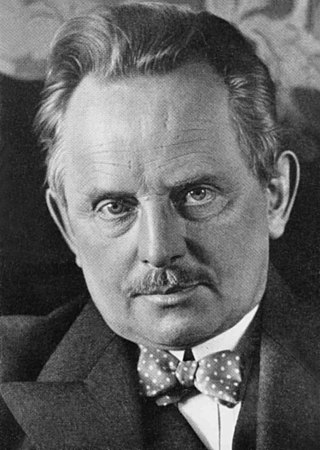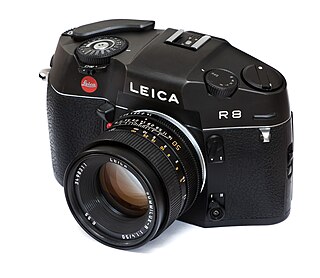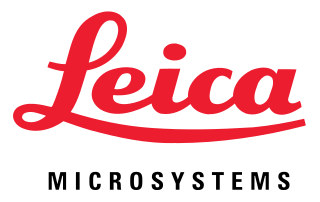
A rangefinder camera is a camera fitted with a rangefinder, typically a split-image rangefinder: a range-finding focusing mechanism allowing the photographer to measure the subject distance and take photographs that are in sharp focus.

Leica Camera AG is a German company that manufactures cameras, optical lenses, photographic lenses, binoculars, and rifle scopes. The company was founded by Ernst Leitz in 1869, in Wetzlar, Germany. The name Leica is derived from the first three letters of the founder's surname (Leitz) and the first two of the word camera: lei-ca.

Leica Geosystems based in eastern Switzerland produces products and systems for surveying and geographical measurement (geomatics). Its products employ a variety of technologies including GPS satellite navigation and laser rangefinders to enable users to model existing structures, terrains in computer based systems to high accuracies, often under 1 cm.

Cosina Co., Ltd. is a manufacturer of high-end optical glass, optical precision equipment, cameras, video and electronic related equipment, based in Nakano, Nagano Prefecture, Japan.

Carl Kellner was a German mechanic and self-educated mathematician who founded in 1849 an "Optical Institute" that later became the Leitz company, makers of the Leica cameras.

Oskar Barnack was a German inventor and photographer who built, in 1913, what would later become the first commercially successful 35mm still-camera, subsequently called Ur-Leica at Ernst Leitz Optische Werke in Wetzlar.

The Wild (Heerbrugg) company (pronounced "vilt") was founded in 1921 in Switzerland. The company manufactured optical instruments, such as surveying instruments, microscopes and instruments for photogrammetry among others. The company changed its name several times, first being known as "Heinrich Wild, Werkstätte für Feinmechanik und Optik", then "Verkaufs-Aktiengesellschaft Heinrich Wild's Geodätische Instrumente", later "Wild Heerbrugg AG", later "Wild-Leitz". The company was linked with Leica in 1989, then it became part of Leica Holding B.V. Its subsidiary Leica Geosystems AG became part of the Swedish Hexagon AB Group of companies in 2005.

The Leica M8 is the first digital camera in the rangefinder M series introduced by Leica Camera AG on 14 September 2006. It uses an APS-H 10.3-megapixel CCD image sensor designed and manufactured by Kodak.

The Leica R8 & R9 are manual focus 35 mm single-lens reflex cameras produced by the German firm Leica as the final models of their R series. Development of the R8 began in 1990: the camera was introduced at the 1996 photokina trade show, and was succeeded by the similar Leica R9 in 2002.

Heinrich Wild was a Swiss businessman, industrial designer, and inventor who was the founder of Wild Heerbrugg, a Swiss optical instruments manufacturing company.

The Leica M7 is a 35 mm rangefinder camera introduced by Leica AG in 2002 as a direct successor to the M6. The electronic Leica M7 is a departure from previous mechanical designs for the M series.

The Leica MP is a 35 mm film camera manufactured by Leica Camera AG that was introduced in 2003. It is an all-mechanical rangefinder focusing camera that follows in a long line of cameras since the Leica M3 was introduced in 1954. The camera uses the Leica M-mount, which accepts all Leica bayonet-mount lenses made since 1954. The 'MP' designation stands for "mechanical perfection."

The Leica M9 is a full-frame digital rangefinder camera from Leica Camera AG. It was introduced in September 2009. It uses an 18.5-megapixel Kodak image sensor and is compatible with almost all M mount lenses.

Leica Microsystems GmbH is a German microscope manufacturing company. It is a manufacturer of optical microscopes, equipment for the preparation of microscopic specimens and related products. There are ten plants in eight countries with distribution partners in over 100 countries. Leica Microsystems emerged in 1997 out of a 1990 merger between Wild-Leitz, headquartered in Heerbrugg Switzerland, and Cambridge Instruments of Cambridge England. The merger of those two umbrella companies created an alliance of the following 8 individual manufacturers of scientific instruments. American Optical Scientific Products, Carl Reichert Optische Werke AG, R.Jung, Bausch and Lomb Optical Scientific Products Division, Cambridge Instruments, E.Leitz Wetzlar, Kern & Co., and Wild Heerbrugg AG, bringing much-needed modernization and a broader degree of expertise to the newly created entity called Leica Holding B.V. group. In 1997 the name was changed to Leica Microsystems and is a wholly-owned entity of Danaher Corporation since July 2005. Danaher is a US venture capital company.

The Leica M is a full-frame digital rangefinder camera of Leica Camera AG. It was introduced in September 2012, and is the successor to the Leica M9 range of cameras. The M uses a 24-megapixel image sensor. The camera is the first M model to feature movie recording, and the first to have Live View, which allows the scene, as viewed through the lens, to be composed. The M can use most M- and R-mount lenses. Leica M cameras are made by hand in Portugal and Germany. There is also a version, the M Monochrom, with a monochrome, rather than colour, sensor.

The Leica M10 is a full-frame digital rangefinder camera in Leica Camera AG's rangefinder M series. It accepts Leica M-mount lenses. The camera model was introduced on 19 January 2017. It is a successor to the Leica M9; and has similarities with and differences to the Leica M, Leica M, and Leica M Monochrom. There are five variants of the M10 line—the M10,M10-P,M10-D, and M10 Monochrom and M10-R.

The Leica L-Mount is a bayonet mount developed by Leica Camera AG for interchangeable-lens autofocus digital cameras.

The name Summilux is used by Leica and Panasonic Lumix to designate camera lenses that have a maximum aperture brighter than f/2, typically at f/1.4, but dimmer than f/1.0. The lens has been in production since 1959 and carries on to the present day.

The Leica M11 is a full-frame digital rangefinder camera from Leica Camera AG. It was introduced on 13 January 2022. It uses a 60.3-megapixel image sensor, and is compatible with almost all Leica M mount lenses.



















